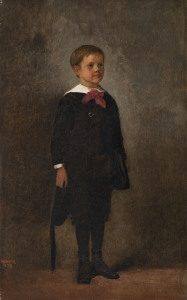ART & DESIGN
Winslow Homer (American, 1836-1910), Charles Prentice Howland, 1878. Oil on canvas, 21 1/8 x 13 ¼ in. (Detail). Image courtesy of Clark Art Institute
ART NEWS
BY KAZAD
A portrait of 9-year-old Charles Prentice Howland by Winslow Homer, the great American painter, shows another side of the artist at Clark Art Institute

Winslow Homer (American, 1836-1910), Charles Prentice Howland, 1878. Oil on canvas, 21 1/8 x 13 ¼ in. (Detail) Clark Art Institute. Gift of Susan Montgomery Howell in Memory of Esther Howland Montgomery and Henry and David Howland, 2014.13
WILLIAMSTOWN, MA—The Clark Art Institute in Williamstown, Mass., has added another painting by Winslow Homer to its large collection of artworks by this great American painter of the nineteenth century. Charles Prentice Howland (1878), an oil painting was donated by Susan Montgomery Howell. The significant and rare commissioned portrait which has never been publicly exhibited reveals another side of Homer, who was celebrated for his detailed depiction of landscapes, turbulent seas, anonymous children at play, doing chores, lounging, and civil war scene.
Charles Prentice Howland captures 9-year-old Charles Howland dressed for school, standing stiffly and perhaps impatiently as he poses for the artist. In his right hand is a tasseled hat and on his shoulder hangs a book bag. The painting which had remained with the family since 1878 is presently on display at the Clark Art Institute with other paintings by the artist. Since it went on display, the painting has continued to be the star of the show in an exhibition filled with Homer’s masterpieces.
Although not generally known for commissioned portraits, there are indications that the portrait is the result of the artist’s long friendship with the boy’s father Henry, a prominent New York judge, and the boy’s uncle, the artist Alfred Howland, both of whom Homer had befriended in Boston in the mid-1850s. In 1860 Homer made bust portraits in watercolor of both Henry and Alfred.
Beyond aesthetics, the story of the sitter is what continues to make this piece endearing to many art lovers. The life history of Charles Prentice Howland exemplifies a Shakespearian tragedy. The son of Henry Howland, a distinguished Judge, Charles Prentice Howland had a passion for law and he grew up to become a lawyer. Sadly at the height of his career in 1932, he was hit and tragically killed by a car on his way from Yale football game.
Susan Montgomery Howell, the sitter’s granddaughter, donated the painting to Clark Art Institute in memory of her mother Esther Howland Montgomery and her Uncles Henry Howland and David Howland. Howell picked Clark Art Institute to receive the donation because of its dual role as a museum and center for research and education. She notes: “I am gratified that this unusual portrait adds another dimension to the Clark’s rich holdings of works by Winslow Homer. I am thrilled that the painting will be available to researchers and on view for the Clark’s many visitors to enjoy.”
ART NEWS | READ ALSO: Portrait of British Actress Olivia Colman Unveiled in London
The Clark Art Institute in Williamstown, Mass., is deeply appreciative of the donation and the addition of the Charles Prentice Howland portrait to its enviable Winslow Homer collection. Clark Director Michael Conforti notes that the donation provides the opportunity for the public to enjoy the artistic excellence of the artist. “We are grateful to Susan Montgomery Howell and her family for giving the Clark this important, little-known painting, which will now be enjoyed by the public. I have long known Charles Prentice Howland’s namesake, C.P. Howland, so it is a true delight that this wonderful connection has brought us together. This portrait fits in beautifully with the Clark’s collection of works by Winslow Homer,” he said adding, “and further enriches the depth of our holdings of Homer’s works.”
